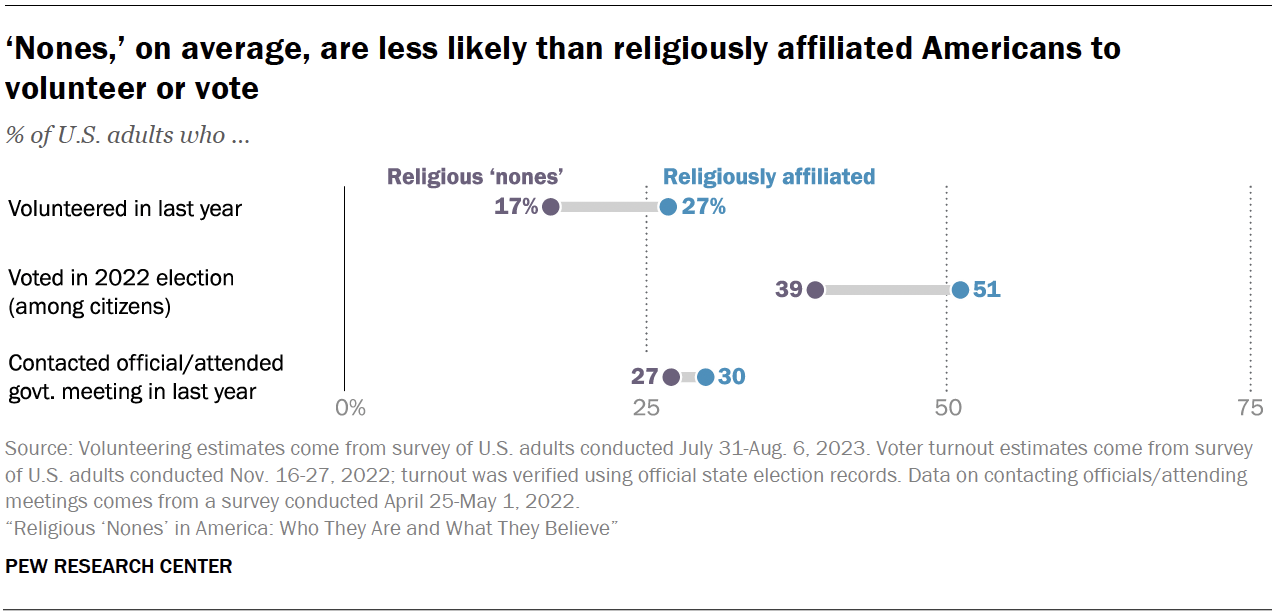Civic Apatheists?
Feb 27, 2025 8:51 pm
Last week, I read Hemant’s newsletter and learned that the Pew Research Center released a new report about the “nones.” I‘ve been reading the report and have many things to say, but today, I will focus on one small aspect. Why are the nones, apparently, less civically engaged than religious people?
According to the report, the nones are less likely to report volunteering and voting. These are markers of social respectability, and defenders of religion often use them to show that being religious is a good thing and the increase of the nones poses a threat to the civic fabric of the country.
The chart presenting this information is quite clear. See below…
The nones are 10 points less likely to report volunteering in the last year and 12 points less likely to report voting in 2022. These differences are a big deal if we care about political power and maintaining and growing a movement. Because the report compares the religious overall and different flavors of Christians with various segments of “the nones,” it makes them look like some apathetic and disengaged mass. Pew just reports this as “fact,” but as always is the case with Pew reports, they lack context. Pew surveys are beautifully done, methodologically speaking, and I love them because they are high-quality, independent checks on some of my research, which is done with fewer resources. Still, its branding as a “nonpartisan fact tank” means that you won’t get any interesting interpretation of such “facts” from their reports. I will provide some interpretation.
So, why are the “nones” less engaged? Let’s start with the obvious: the ones who are less engaged tend to be those who identify their religion as “nothing in particular.” There are two other segments of the nones: those who declare their religion “atheist” or “agnostic.” The “nothing in particular” segment accounts for 63 percent of the nones, “atheists” 17 percent, and “agnostics” 20 percent.
This makes sense if we understand what being an “atheist” or an “agnostic” in this context. People who say they are atheist or agnostic as a religion tend to be more activist in their secularism, as we can see indirectly in the table above. Atheists and agnostics are more likely to report volunteering than people who say their religion is “nothing in particular.”
Religious people report higher levels of volunteering than the nones overall and than self-described atheists and agnostics. Over one-quarter (27%) of the religious report volunteering, while about one in five (21% and 22%) atheists and agnostics report volunteering. However, when asked if they are involved in a nonreligious or community service group, the difference between religious people (17%), atheists (17%), and agnostics (19%) disappears. In essence, a lot of religious people do their volunteering in church. I’m not saying that church is not actual volunteering, but that because churches/temples/congregations are also voluntary associations, much of their volunteering is double-counted.
It is worth noting that even though atheists (27% under 30)and agnostics (38% under 30) are far younger than religious people (14% under 30), they have higher levels of educational attainment. Nearly half (48%) of atheists and agnostics have a college degree, compared to about a third (34%) of the religious. Furthermore, 78% of atheists and 81% of agnostics have at least some college, some of it probably because they are so young. Among the religious, over one-third (36%) have a high school education or less.
What about those who identify as “nothing in particular”? They are also much younger than the religious; 27% are under 30, twice as much as the 14% of religious people in that age bracket. However, they are less likely to have a college degree and more likely to have never attended college. 27% of those identifying as nothing in particular are college graduates, and 43% have a high school diploma or less.
We are dealing with two different secular populations. One is highly educated and very white (77% of atheists and 69% of agnostics are white) and male (64% of atheists and 62% of agnostics are men). The other one is more racially diverse (43% people of color), majority women (55%), and with lower levels of educational attainment.
Everything about civic and political participation in this country boils down to networks and resources. Atheists and agnostics have more social capital to pull from, and that makes the advantage religious people have negligible. The nones who do not belong to the self-identified atheists and agnostics are part of a different world. One that is in, for lack of a better world, limbo. Not secular enough for the secular movement folk, not religious enough to return to church (because they are, more likely than not, former Christians).
If the secular movement want to be a real force in politics, it needs to learn how to reach out and talk to those who are not self-identified atheists and agnostics. It is something I have been saying for a while. You can read my “Boundaries of Secularism” article in Free Inquiry based on my series “The Boundaries of Secularity” or my interview in Point of Inquiry dealing with this issue of community.
Other news
I’ve been busy working and traveling, and the newsletter has slipped off my radar in the last few months. But I still intend to continue as I have a bunch of original content to share. In the next few weeks, I’ll be making some announcements about newsletter-related projects. But I want to wish you a belated happy New Year!



